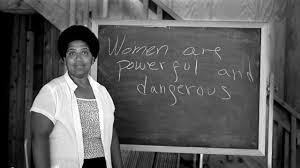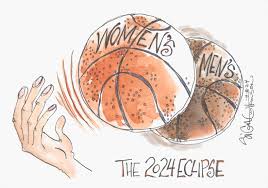1
Section One: The Fundamentals
A) What do we know about sport? What are common assumptions we make about sport and society?
| The above statements are not a universal truth for those who participate in sports, as many markers of a person’s identity are not reflected by the statements. For example, the statement “sport transcends politics” is true in the sense that sports have objective goals within themselves, however politics exists within sports when looking into conversations about gender, more specifically, conversations surrounding the struggles faced by women and transgender people. Politics also exists in how one may express their sexualities through their sports attire or equipment, leading to hateful conversation about an athlete’s sexuality. |
Exercise 3: Notebook prompt
What are some other metanarratives about sport that you are familiar with? Find an image or video clip or draw something yourself that captures this idea…
So what? Why does any of this matter? Does it matter? As something we grow up with – live with – play through – we don’t often interrogate the meanings of sport, and perhaps we don’t want to.
But being aware of these assumptions and metanarratives is especially important, I would argue, because of the centrality of sport to our everyday lives, the role that sport plays in shaping our childhood and worldviews and….. [finish that thought]
| Sport is full of metanarratives that ultimately shape how we see competition, success, and identity. The belief in sport as a meritocracy suggests that talent and hard work alone determine success, often overlooking structural inequalities. The example of “underdog” story inspires with the idea that against all odds, a weaker team or individual can defy all odds through determination. The notion of sport as a unifier emphasizes its ability to bring people together across cultural, national, and political divides, while winning at all costs reinforces the idea that victory justifies any means, sometimes leading to unethical practices like doping and using sports enhancements. Additionally, the athlete as a “hero” narrative places sports figures on a pedestal, expecting them to embody moral excellence and serve as role models. These narratives matter because they shape values and reinforce societal norms, often without question. Sport is deeply rooted in culture, and while we celebrate its drama and spectacle, we rarely analyze the meanings behind these stories. |
B) What is social justice?
Exercise 4: Padlet Prompt
Think back to the last section and try to look at some of the ideas we discussed differently. How might sport and social justice actually co-exist?
Record any images, video clips, or gifs you added to the padlet and identify a point of intersection between sport and social justice (can be an issue or a barrier or a debate or something you would like to explore in more depth in this course) . Screenshot or paste in your response below.
| Sport and social justice can co-exist when athletes, organizations, and fans utilize sport as a platform for advocacy and change. Throughout history, sports have provided a stage for activism, from Muhammad Ali’s stand against the Vietnam War to Colin Kaepernick’s protest against racial injustice. When athletes speak out on issues like racism, gender equality, and LGBTQ+ rights, they challenge the notion that sport is separate from society. Leagues and governing bodies can also promote social justice by implementing policies that ensure fair pay, equal opportunities, and inclusivity in sports at all levels. However, this coexistence is often met with resistance, as some believe sport should remain “neutral” and free from politics. Despite this, the power of sport to bring together and inspire change proves that social justice and athletics are not mutually exclusive but can thrive together in meaningful ways. |
C) Social Justice Reading
(note: this activity is optional!)
D) KINESIOLOGY AND SOCIAL JUSTICE
Exercise 5:
Exercise 6:
What are the implications of bodies-at-risk discourse and the refusal to understand the health gap from a social justice perspective, according to the authors of this article?
| The “bodies-at-risk” discourse as discussed in the article, is deeply rooted in deficit thinking, which frames marginalized groups as inherently disadvantaged or deficient in health, fitness, and physical activity. This perspective reinforces racialized narratives that maintain whiteness as the norm and pathologize the health behaviors of ethnic minorities, individuals with disabilities, and people in poverty. The failure to address the health gap from a social justice perspective perpetuates these harmful narratives, reducing health disparities to issues of personal responsibility rather than recognizing systemic barriers such as racial exclusion, economic inequality, and historical discrimination. The authors argue that addressing health disparities requires moving beyond deficit models and embracing intersectionality, critical race theory, and counter-narratives that acknowledge and validate the lived experiences of marginalized communities. |
Section Two: Sport Feminism
Exercise 7: Notebook Prompt
What is feminism? What does it mean to you? Choose one of the images below and explain how it captures your understanding of feminism (or find one that does speak to you and paste this into your pressbook with an explanation of why it matters to you.

Feminism is defined as the belief in and advocacy for gender equality, challenging systems of oppression such as sexism, racism, and classism. It is not a singular ideology but evolves with issues of race, sexuality, and identity. To me, feminism represents liberation, empowerment, and justice. It goes beyond gender, addressing interconnected forms of oppression, amplifying marginalized voices, and striving for a more equitable world. I chose the image of Audre Lorde, as she embodied the vision as a Black, queer, poet, and activist, emphasizing that feminism must be intersectional. In “The Master’s Tools Will Never Dismantle the Master’s House,” she criticized mainstream feminism for excluding marginalized voices and argued that justice must be inclusive of race, class, and sexuality. She believed diversity should be embraced, not erased. Lorde’s work reminds us that feminism must be radical, inclusive, and transformative, ensuring liberation for all oppressed groups, not just a privileged few. Her legacy challenges us to rethink justice and activism in a way that values every identity and experience. |
Exercise 8: Notes Prompt (optional)
NB: Cornell notes is a great resource that teaches effective notetaking. Unfortunately, our system can’t save notes taken in the H5P app, so this is fully optional.
Exercise 9: Crossword Activity
Exercise 10: Padlet Prompt
|
|

|
|

